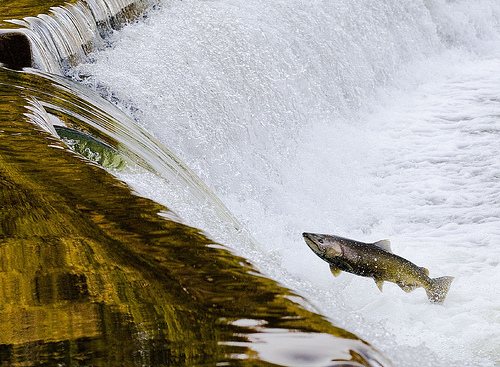The Army Corps of Engineers has some explaining to do.
They’ve just announced that, at least for the time being, Ambre Energy’s proposed coal export terminal on the Columbia River only needs a streamlined environmental assessment, rather than a more comprehensive environmental impact statement. Which means, as Scott Learn from The Oregonian writes, that Ambre’s project “is staying on the fast track.”
It’s hard not to think that the Corps is caving to pressure from the coal industry here. Let’s leave aside, if you will, the potential risks to human health—such as coal’s well-known problem with spontaneous combustion, or the many impacts on rail-side communities from coal dust. Ambre’s own consultants, in a biological assessment prepared earlier this year for the company, admitted that the Morrow Pacific coal export project will have signficant impacts on threatened and endangered fish populations and their habitat.
Here are some choice quotes from the coal industry’s own report:
- “Project construction activities at the Port of Morrow site will affect these [fish populations] through noise impacts, turbidity, and other habitat impacts (such as shading and the potential for accidental spills) during project construction.”
- “Critical habitat components for Chinook salmon will be affected by the proposed project.”
- “Ongoing negative impacts to water quality, substrate at the docks, and food resources may occur as a result of project operations. As a result, the proposed project may affect, and is likely to adversely modify, critical habitat for UCR spring-run Chinook salmon, SR fall-run Chinook salmon, and SR spring/summer-run Chinook salmon.”
- “Shading from the conveyor, walkway, and pilings at the Port of Morrow, as well as staged barges and tugs, may increase predation in the area around the new mooring facility. Habitat disturbance and shading will also occur from vessel operation at the Port of Morrow dock.”
- “The proposed project may affect, and is likely to adversely modify, critical habitat for southern green sturgeon.”
I could go on and on—there are pages and pages of this. Fish throughout the Columbia River Watershed would be affected: Upper, Middle, and Lower Columbia River steelhead; Snake River steelhead; Willamette River steelhead; chum; bull trout; euchalon; green sturgeon. The project could even affect sea lions, orcas, and sea turtles (though the report downplays the impact on these endangered species).
The EPA was so concerned about the project that it asked the Corps for a “broadly scoped cumulative impacts analysis” not only of the Morrow Pacific project, but of all of the proposed coal export projects that coal companies are pressing forward on. The Washington State Department of Natural Resources asked for a full EIS for the project, as did the city of Mosier, OR, downstream from the Morrow project, and the Nez Perce tribe as well. Meanwhile the Yakama Nation asked for a comprehensive, programmatic EIS for coal exports more broadly, as did Oregon’s governor, John Kitzhaber and Oregon Senator Jeff Merkley.
So on this one, it’s the Corps and the coal industry vs., well, lots and lots of us.
Hope is not lost, though: the “fast track” might not be all that fast. Late last week, the president of Ambre’s project (Ambre is a many-tentacled coal and oil shale conglomerate based in Australia) announced that it’s been forced to push the start date for the Morrow Pacific project back into 2014. And the streamlined environmental review could still turn up enough new data that the Corps could ask for a more thorough EIS.
Still, the Corps is on shaky ground here. It’s already announced that a proposed coal terminal at Longview, WA does, in fact, require an EIS. Based on current figures (which could very easily change—Ambre’s been less than truthful in the past about the scope of its plans) the proposed Longview export project would handle 5 to 6 times as much coal as the Port of Morrow project. Yet the fact that Longview gets an EIS while Morrow gets a pass presents a serious problem. It’s almost like the Corps is sending a signal to the coal industry: pare back your projects and you can get a streamlined review. That’s a recipe for nickel and diming the Northwest into becoming a major coal export hub—and all the more reason to support a comprehensive, combined review of all of the coal export proposals for the region, not the piecemeal, inconsistent, and risk-filled approach that the Corps seems to be taking.


Comments are closed.